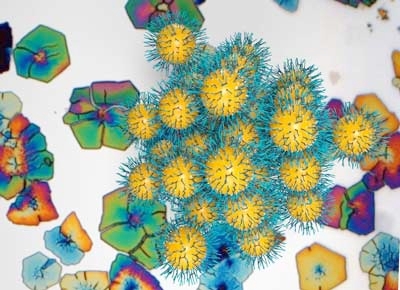|
NOVIDADES
Nanoparticles are measured in nanometers, which are one billionth of a meter long. Nanoparticle superlattices are a type of group of these particles. This type of group has properties that are different from both the individual particles and the bulk material. Ions and molecules called ligands bind particles together in these superlattices. New research (Nanoscale, "Ligand dynamics control structure, elasticity, and high-pressure behavior of nanoparticle superlattices") shows how the ligands affect key structural and mechanical properties of the superlattices. The relationship between the number of binding ligands, how much they move on a nanoparticle surface, and how they move in the spaces between nanoparticles determine these properties.  Forward image created by coarse-grained molecular dynamics simulation. It depicts a superlattice of nanoparticles (yellow) stabilized by ligands (blue). Background image of the superlattice taken by optical microscopy. (© Nanoscale)
This discovery will help scientists better control properties of these superlattices. This knowledge is crucial for scientists to create next-generation materials for energy technologies. To explore dynamic processes at the molecular level, faceted NPSL analogues of atomic crystals were synthesized in a toluene solution and characterized using scanning electron microscopy (SEM) at CNM, characterized using in situ small angle X-ray scattering techniques at APS, and modeled using molecular dynamics simulations in part at CNM. The nanoparticle superlattices consist of lead sulfide nanoparticles with capping oleic acid ligands. The results show that ligand coverage density dictates several key factors: the extent of diffusion of ligands over the nanoparticle surfaces, the spatial distribution of the ligands in the interstitial spaces between neighboring nanoparticles, and the fraction of ligands that interdigitate across different nanoparticles. Below a critical coverage density, the nanoparticle superlattices collapse to form disordered aggregates, even under ambient conditions. Above that coverage density, the nanoparticle superlattices surprisingly preserve their crystalline order even under very high applied pressures (approximately 40–55 GPa). Also, the interparticle spacing decreases with the applied pressure but returns to the original spacing upon pressure release. The combined results suggest the possibility of reversibly manipulating the lattice spacing of nanoparticle superlattices, and in turn, finely tuning their collective electronic, optical, thermo-mechanical, and magnetic properties. U.S. Department of Energy, Office of Science. Accessed: Jan 02, 2020.
|
|||||||||||||||||||||||||